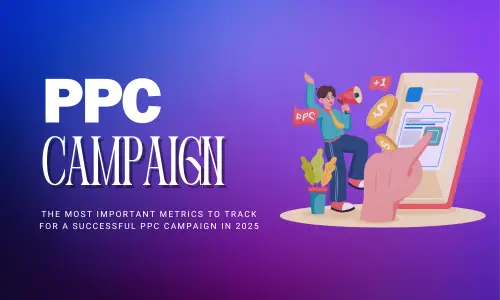The Most Important Metrics to Track for a Successful PPC Campaign in 2025

What is CRM Software (Customer Relationship Management)
March 21, 2025
Why should small businesses use digital marketing?
March 24, 2025Pay-per-click advertising remains a powerhouse for driving targeted traffic and boosting revenue in the digital landscape. As we dive into the evolving world of online marketing, The Most Important Metrics to Track for a Successful PPC Campaign in 2025 become the compass guiding advertisers toward efficiency and growth. With advancements in AI-driven bidding and heightened data privacy regulations, focusing on these key indicators ensures campaigns not only survive but thrive amid competitive pressures.
This guide explores the vital metrics that matter most, breaking them down with practical insights for implementation. Whether you’re managing Google Ads, Microsoft Advertising, or social platforms like Facebook, understanding these elements empowers data-backed decisions. Let’s uncover how to measure, optimize, and scale your efforts effectively.
Why PPC Metrics Matter More Than Ever in 2025
The advertising ecosystem shifts rapidly, influenced by algorithm updates, user behavior changes, and economic factors. Traditional vanity metrics like impressions often mislead, while performance-driven ones reveal true ROI. In 2025, with cookie deprecation fully in effect and AI optimizing ad placements in real-time, tracking the right data prevents wasted budgets and uncovers hidden opportunities.
Advertisers who prioritize these metrics report up to 30% higher returns, according to industry benchmarks. They provide a holistic view: from initial engagement to final conversions. By monitoring them weekly or even daily, you align campaigns with business goals, whether that’s lead generation, e-commerce sales, or brand awareness.
The Role of AI and Privacy in Metric Evolution
Artificial intelligence now handles much of the heavy lifting in PPC, from predictive targeting to dynamic creative optimization. Yet, this tech amplifies the need for precise metrics. Privacy laws like GDPR and CCPA demand consent-based tracking, making first-party data king. Metrics that adapt to these changes—focusing on consented interactions—help maintain compliance while maximizing reach.
For instance, Google’s Performance Max campaigns rely on signals from multiple channels. Here, aggregated metrics across touchpoints offer clearer insights than siloed data. Embracing this shift means auditing tools like Google Analytics 4 or server-side tagging for accuracy.
Click-Through Rate (CTR): The Engagement Gateway
Click-through rate measures the percentage of impressions that result in clicks, calculated as (Clicks / Impressions) x 100. A strong CTR signals resonant ad copy and relevance, directly impacting Quality Score and ad rankings.
In 2025, aim for a benchmark of 2-5% across industries, though e-commerce might hit 3-7%. Low CTRs inflate costs and signal mismatches between keywords and landing pages. To boost it, A/B test headlines incorporating user intent—think long-tail phrases like “best wireless earbuds under $50.”
High CTR alone doesn’t guarantee success; pair it with qualitative reviews from tools like Hotjar to understand why users click. Regular audits reveal patterns, such as mobile vs. desktop performance, allowing tailored optimizations.
Optimizing CTR for Mobile-First Audiences
With over 60% of searches on mobile, responsive design becomes non-negotiable. Metrics show that ads loading under three seconds can lift CTR by 20%. Use AMP pages and compress images to enhance speed. Additionally, location-based extensions in PPC platforms capture hyper-local traffic, pushing CTRs higher in competitive markets.
Cost Per Click (CPC): Balancing Budget and Bids
Cost per click tracks the average amount paid per ad interaction, influenced by competition, Quality Score, and bid strategies. Formula: Total Cost / Total Clicks. In 2025, average CPCs hover around $1-2 for search ads, but niches like finance can exceed $50.
Rising costs from auction dynamics make CPC a frontline metric. Smart Bidding in Google Ads automates adjustments, but manual reviews ensure alignment with ROAS targets. If CPC spikes unexpectedly, investigate seasonal trends or negative keywords to refine targeting.
Effective management keeps campaigns lean. For example, excluding branded searches from non-brand campaigns can slash CPC by 15-20% without losing visibility.
Strategies to Lower CPC Without Sacrificing Reach
Leverage audience segmentation to bid smarter—remarketing lists often yield 40% lower CPCs due to higher conversion potential. Experiment with broad match modifiers alongside exact phrases for broader yet controlled exposure. Tools like SEMrush provide competitor bid insights, helping you outmaneuver rivals economically.
Conversion Rate: Turning Clicks into Actions
Conversion rate gauges the percentage of clicks leading to desired outcomes, such as form submissions or purchases: (Conversions / Clicks) x 100. Benchmarks vary: 2-5% for B2B, up to 10% for retail.
This metric bridges awareness and action, highlighting landing page efficacy. In 2025, with voice search rising, optimize for conversational queries to improve relevance and lift rates. Micro-conversions like newsletter sign-ups serve as proxies when full sales lag.
Tracking multi-step funnels reveals drop-offs; heatmaps from Crazy Egg pinpoint friction points for fixes like simplified checkout flows.
Enhancing Conversion Rates Through Personalization
Dynamic content matching user data—via first-party cookies—can increase rates by 25%. AI tools like Adobe Sensei suggest personalized ad variations. A/B testing CTAs, such as “Get Started Free” vs. “Claim Your Trial,” often uncovers winners tailored to audience segments.
Return on Ad Spend (ROAS): The Profitability Pulse
ROAS calculates revenue generated per dollar spent: Revenue from Ads / Ad Spend. A 4:1 ratio means $4 back for every $1 invested—solid for most sectors, though luxury brands target 8:1+.
As e-commerce booms, ROAS dominates boardroom discussions. In 2025, attribution models like data-driven in Google Analytics attribute value across sessions, preventing underestimation from last-click biases. Seasonal campaigns demand vigilant tracking to adjust for holiday surges.
Strong ROAS stems from value-based bidding, where platforms prioritize high-LTV customers. Integrate CRM data for holistic views, revealing lifetime value beyond initial sales.
Calculating and Scaling ROAS Effectively
Start with e-commerce tracking pixels for accurate revenue capture. Exclude taxes and shipping to focus on pure ad-driven income. Scale winners by increasing budgets 20-50% incrementally, monitoring for diminishing returns. Cross-channel ROAS, blending PPC with email, often amplifies overall efficiency.
Impression Share: Gauging Visibility Gaps
Impression share reflects the percentage of eligible impressions your ads capture: (Impressions Received / Eligible Impressions) x 100. Lost impression share due to rank or budget highlights missed opportunities.
In competitive 2025 landscapes, target 70-80% share for top keywords. Low figures signal underbidding or poor ad rank. Use search terms reports to expand negatives, freeing budget for high-intent terms.
This metric ties into market share; improving it through Quality Score enhancements can double visibility without extra spend.
Addressing Lost Impression Share Proactively
Budget-paced campaigns prevent early exhaustion. For rank losses, refine ad relevance—extensions like sitelinks boost scores. Competitor analysis via Auction Insights reports competitors’ shares, guiding aggressive bids where margins allow.
Quality Score: The Efficiency Multiplier
Google’s Quality Score rates ad relevance, landing page experience, and expected CTR on a 1-10 scale. Higher scores lower CPCs and improve positions.
In 2025, with AI evaluating user signals, maintain 7+ scores for cost savings up to 50%. Core Web Vitals now factor in, emphasizing load times and interactivity.
Audit pages quarterly: Ensure mobile-friendliness and fast servers. Ad copy alignment with queries prevents mismatches.
Boosting Quality Score with User-Centric Design
Incorporate schema markup for rich snippets, enhancing click appeal. User feedback loops, like post-click surveys, refine experiences. Consistent branding across ads and sites builds trust, indirectly lifting scores.
Customer Acquisition Cost (CAC): Long-Term Viability Check
CAC divides total acquisition spend by new customers: Total Marketing Spend / New Customers Acquired. Compare against customer lifetime value (CLV) for sustainability—aim for CAC under 1/3 of CLV.
PPC contributes heavily; track it separately to isolate channel performance. In 2025, rising ad costs push CACs toward $100+ in SaaS. Optimize by nurturing leads with automated emails post-click.
This metric forecasts scalability; high CACs prompt diversification into organic channels.
Integrating CAC with Broader Funnel Metrics
Blend with LTV calculations using cohort analysis in tools like Mixpanel. Predictive analytics forecast future CAC trends based on economic indicators. Adjust PPC allocations quarterly to keep ratios healthy.
Final Thoughts on PPC Mastery
Mastering these metrics transforms PPC from a cost center to a growth engine. Regularly review dashboards, set alerts for anomalies, and iterate based on trends. In 2025’s dynamic arena, agility wins—those who adapt metrics to emerging tech like zero-party data collection stay ahead.
Commit to monthly deep dives, fostering a culture of experimentation. Your campaigns will not only perform but evolve, delivering sustained value in an ever-shifting digital world.


